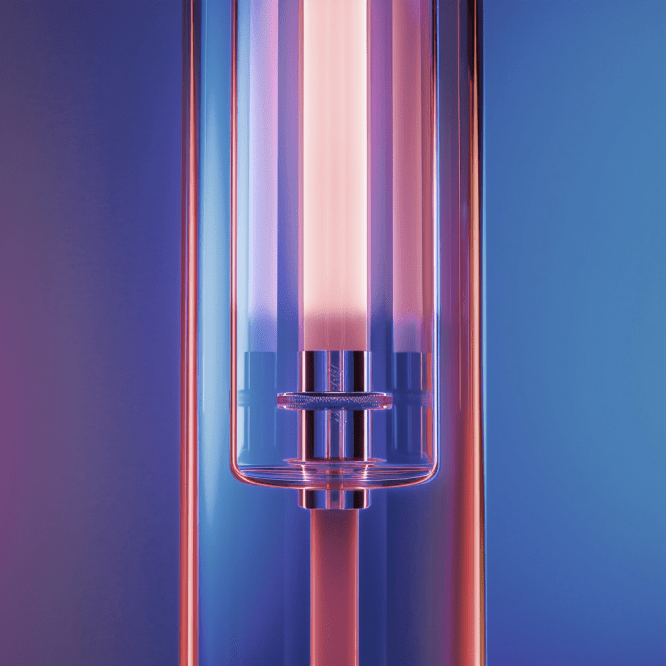USE CASES
Quantum business impact
Our quantum algorithms team creates industrial solutions for various applications, including advanced simulations for pharmaceuticals and material design, as well as quantum machine learning for networks.

AUTOMOTIVE & AEROSPACE
Combustion reaction in heat engine
PROBLEMS
Simulating complex aerodynamic phenomena is crucial in aeronautics and space industry. These sectors face high computational costs for accurately modeling turbulent flows and combustion process.
SOLUTIONS
Quandela has a photonic native Variational Quantum Differential Equation solver that is highly flexible in addressing various types of differential equations.
BENEFITS
Our solution can potentially perform more accurate and efficient fluid dynamics simulations, enhancing the capability to model extreme conditions and complex flows. It has the capacity to reshape the design and performance of advanced aerospace systems, potentially leading to innovations in aircraft and spacecraft propulsion, aerodynamics, and overall efficiency.

AUTOMOTIVE & AEROSPACE
Artificial image generation
PROBLEMS
AI models require large and diverse training datasets, especially for specialized scenarios in automotive and aerospace applications. Acquiring a wide range of images for various conditions (e.g., different lighting, weather, or environments) can be expensive, time-consuming, and sometimes impractical. Complex image transformations often require more than simple modifications to existing images.
SOLUTIONS
Our Quantum Generative Adversarial Network (QGAN) algorithm generates artificial images based on existing image datasets. This allows for the creation of diverse, synthetic images that represent a variety of scenarios and conditions.
BENEFITS
This method can significantly reduce the cost and time for acquiring specialized image data. It increases the diversity in training datasets for AI models, bringing the industry closer to more robust and accurate AI systems for various operational conditions. The ability to generate artificial images for multiple scenarios enhances the versatility and applicability of AI models in automotive and aerospace sectors.

CHEMISTRY
Polymer classification using quantum machine learning
PROBLEMS
The dimensionality of quantum chemistry applications often grows exponentially, making large-scale simulations computationally challenging. This complexity hinders the analysis and classification of polymers based on specific features, a task crucial for various scientific and industrial applications.
SOLUTIONS
Quandela and Alysophil have developed a hybrid classical-quantum algorithm to cluster polymers given specific features, with the goal of tackle large-scale simulations. We use a pre-trained classical neural network to extract essential features of the data. These features are analyzed by a quantum neural network that classifies the polymers. This transfer learning process leverages the strengths of both classical and quantum computing, creating a powerful hybrid quantum-classical neural network.
BENEFITS
Preliminary results agree with classical simulations, paving the way for further developments of quantum algorithms. The successful implementation of this technique could significantly accelerate research in materials science, potentially leading to innovations in polymer design and applications across various industries.

CHEMISTRY
Simulate the properties of large molecules
PROBLEMS
Understanding molecular behavior is key to help solve the most pressing problems society is facing, such as in climate change, drug discovery, and material science. However, predicting the properties of a molecule with accuracy can only be done for molecules with a few atoms. For instance simulating a 24-atom caffeine on today's classical computers would take longer than the age of the universe. Quantum computing holds the promise to advance significantly in addressing large-scale molecular dynamic simulations.
SOLUTIONS
Quandela developed a state-of-the-art method that combines molecule fragmentation techniques such as Density Matrix Embedding Theory (DMET) and Variational Quantum Eigensolvers (VQEs) to tackle large molecules simulations.
BENEFITS
Our solution is on track to compute the properties of realistic chemical systems by increasing ground energy accuracy, with the potential to tackle largely entangled subsystems of proteins.

CYBERSECURITY
Random numbers generation
PROBLEMS
Traditional random number generators, which often rely on deterministic algorithms or physical processes that can be influenced or predicted, have proven vulnerable to attacks. In several high-profile cases, classical random number generators were compromised or tampered with, leading to significant security breaches.
SOLUTIONS
We have invented and developed the Entropy protocol on our full-stack quantum computer MosaiQ. This unique combination generates quantum-certifiably random numbers. Our approach involves both theoretical and experimental contributions. We measure the potential information an eavesdropper could use to fake a violation of locality. We set a performance bound for the device to produce certified random numbers. The device periodically self-tests to validate these numbers. We provide experimental validation on MosaiQ.
BENEFITS
Quantum advantage in data encryption on a small-scale photonic device. It produces intrinsically random numbers with quantum certification. The system is robust against against potential eavesdropping attempts. Periodic self-testing ensures ongoing reliability and experimentally validated solutions, bridging theory and practice.

ENERGY
Stress simulation of large mechanical constructions
PROBLEMS
Simulating complex structural mechanics in large mechanical constructions, such as hydroelectric dams, bridges, or skyscrapers, requires solving computationally intensive partial differential equations. High precision is crucial in critical infrastructure, where minor errors can lead to catastrophic failures.
SOLUTIONS
Quandela’s Variational Quantum Differential Equation (VQDE) solver, known for its precision, models stress tensors and calculates optimal displacement fields.
BENEFITS
Our solution offers improvements in accuracy of simulation of structural mechanics in complex systems and potential speed ups in computation times. It enhances the ability to predict and prevent structural failures across various types of large mechanical constructions. This technology can be applied to a diverse range of projects, from hydroelectric dams to innovative architectural designs, enabling more efficient and reliable infrastructure development and maintenance.

ENERGY
Energy consumption prediction
PROBLEMS
Accurate energy consumption and production forecasting is crucial for efficient energy management and grid stability. However, energy systems' high complexity and non-linearity make predictions extremely challenging for classical methods.
SOLUTIONS
We have designed a photonic quantum reservoir computing algorithm to predict energy consumption and production in time.
BENEFITS
Our method can potentially improve the accuracy of forecasts, bringing us closer to reducing computational resources compared to classical methods.

FINANCE
Predicting Loan Defaulters
PROBLEMS
Financial institutions typically use classical models to assess the risk of lending money to entities. Whether it is a person, a company, or the government, there are standards to label them from the safest to the riskiest for investment. However, more often than not, entities classified as "safe" end up defaulting on their loans. Financial institutions aim to predict these "loan defaulters" in advance. Data to predict loan defaulters may be scarce or unbalanced which makes it a challenging task for classical computers. Improving by a few points in accuracy their predictions could generate millions in revenue.
SOLUTIONS
Quandela has created a photonic hybrid boosting classifier that combines the strengths of classical models with the novelty of a photonic quantum classifier.
BENEFITS
Our method has been shown to outperform the classical approach, allowing for a better prediction of loan defaulters.

LOGISTICS
Optimizing trajectories for drones and warehouse robots
PROBLEMS
Managing and optimizing the movement of multiple autonomous agents, such as drones in aerospace or robots in warehouses , is complex due to numerous constraints (no-fly zones, positioning accuracy, energy limitations). Collision avoidance in fleet or swarm drone missions is critical and computationally challenging. Classical algorithms struggle with the scale and complexity of multi-drone coordination.
SOLUTIONS
Quandela has developed a Quantum Reinforcement Learning (QRL) algorithm, a solution with the potential to provide faster results and increase the number of constraints considered in multi-agent traffic optimization.
BENEFITS
Our solution holds the potential to create more efficient and safer operations in complex environments, from drone fleets to warehouse automation, as well as improved collision avoidance systems and optimized path planning for autonomous agents. This could represent a competitive advantage in the growing markets of drone technologies and warehouse automation, potentially increasing operational efficiency and reducing costs. We have successfully tested a proof of concept.

PHARMACEUTICALS
Bioremediation
PROBLEMS
Bioremediation is a process that employs biological systems, typically bacteria, microalgae, or fungi, to remove environmental pollutants from air, water, or soil. Molecular docking, a key method in understanding these processes, predicts the binding of small molecules to the target site, using the structures of both elements. However, this combinatorial method for screening large databases of docking configuration candidates faces significant challenges. Efficient exploration of vast chemical spaces is extremely difficult with classical approaches.
SOLUTIONS
Quandela has developed a Boson sampling based dense-subgraph identification algorithm to address the computational challenges in molecular docking for bioremediation.
BENEFITS
Our solution can significantly enhance the accuracy in identifying promising candidates for bioremediation processes, thereby supporting more efficient pollutant removal strategies. This application of quantum computing also fosters collaboration between quantum experts and life scientists, potentially accelerating advancements in environmental remediation techniques and addressing pressing environmental challenges.
find out more
Start your journey with the power of quantum
Find out what our Photonic Quantum power can do for you.
